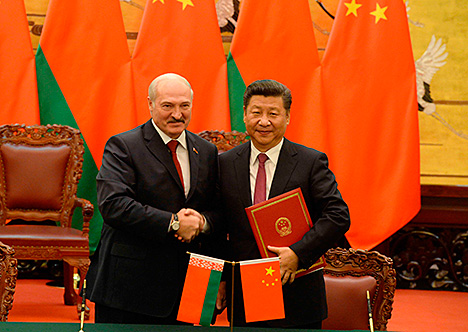
A vast, mostly empty industrial park just outside of Minsk, Belarus, might seem like an unlikely locus of high-tech Chinese innovation. In January, however, it was announced that the China–Belarus Great Stone Industrial Park will be designated as the first of Belarus’s special economic zones for the Eurasian Economic Union in an attempt to lure more Chinese technology companies to invest in Belarus.
As the largest foreign investment project in the country (literally as well as metaphorically—the park is eventually planned to be over 112 square kilometres), Great Stone is the crown jewel in China’s increasingly active engagement with Belarus. The special economic zone will form a bridge between the Eurasian Economic Union and China’s Belt and Road projects, giving Chinese companies tax-free entry to markets in Russia and Central Asia.
In his 2018 state-of-the-nation address, Belarusian President Alexander Lukashenka praised the rapid development of Chinese–Belarusian relations. Significantly, he rhetorically placed relations between China and Belarus on an equal footing with relations between Belarus and Russia.
‘We will strengthen the relations in the eastern direction: both with Russia and with the PRC. For Belarus these relations are the strongest support and an asset’, Lukashenka said.
Chinese investment has poured into Belarus over the past five years. Technology is a prominent theme. In addition to Great Stone, Belarus and China have signed an agreement to establish a research and development centre with a focus on smart technologies, computer semantics and artificial intelligence systems. Chinese investment has also gone into Belarusian railways, infrastructure, construction and manufacturing. China is now Belarus’s third most significant trading partner after Russia and Ukraine, with trade expected to top $3.5 billion in 2018—just a drop in a very large bucket for China, but highly significant for Belarus.
Defence and security ties between the two nations are also strengthening. China has helped the Belarusian army develop its missile and satellite capabilities. In 2018, PLA troops participated for the first time in Belarus’s Independence Day parade along with Belarusian and Russian servicemen. National security and policing is another area in which Belarus (often referred to as Europe’s last dictatorship) is being encouraged to look to China as a model, especially in the area of high-tech surveillance.
People and ideas are following the flow of money and technology. In October 2018 a Chinese–Belarusian visa-free agreement came into force. Both governments are promoting educational and language exchange programs for students. Lukashenka’s son Kolya, who is reportedly being groomed to take over the leadership after his father, released a congratulatory message in Chinese for the 2018 spring festival.
A very different sort of travel experience is being had by thousands of Chinese workers in Belarus, including those constructing Great Stone, who are reportedly working under terrible conditions with little or no oversight from Belarusian authorities.
The sudden blossoming of the China–Belarus relationship has its roots in the strategic interests of both countries. To mix metaphors, however, the situation is made much more complex by the elephant in the room—or rather, the bear.
What China stands to gain from deepening its relationship with Belarus is relatively straightforward. Belarus might be extremely small potatoes as a trading partner, but its geographic location makes it a key link between the Asian and European stretches of the Belt and Road project. The ‘green transport corridor’ planned to connect Germany and China runs straight through the middle of Belarus. Belarus also forms a valuable economic and political stepping stone for China into the larger and profitable Russian and Central Asian markets.
Belarus’s game is more complex. The desire for Chinese investment is obvious: the Belarusian economy is still recovering from recession, and Lukashenka has never been one to turn down an influx of foreign cash.
However, another part of the motivation in cosying up to China is likely to be the desire for a new counterweight to balance off against Russia. For decades, Lukashenka has danced a difficult two-step between Russia and the EU, in an effort to give himself a little wriggle room despite his nation’s fundamental reliance on Russian loans and subsidies. By periodically appearing to flirt with the idea of liberalisation and closer ties with the EU, Lukashenka has been able to negotiate better deals than Belarus would likely otherwise have received from its vastly more powerful neighbour.
But with the EU’s attention focused on its own internal turmoils, the old tricks are no longer working, and Russia knows it.
Putin has increasingly been turning the screws on Lukashenka (the personal animosity between the two men is well known), cutting loans and subsidies and threatening Belarusian exports. In recent weeks, relations between Russia and Belarus have approached crisis point. Even more disturbingly for Lukashenka, the ever-present rumours that Russia has plans to annex Belarus have grown significantly louder than usual.
Lukashenka is in dire need of leverage. It is becoming more and more apparent that he hopes to cast China in the role of the absent EU, allowing him to prolong his decades-old highwire balancing act with Russia.
The question is, how much is the relationship with Belarus really worth to China—and is it enough to risk setting up a possible rivalry with Russia right on Russia’s border?

